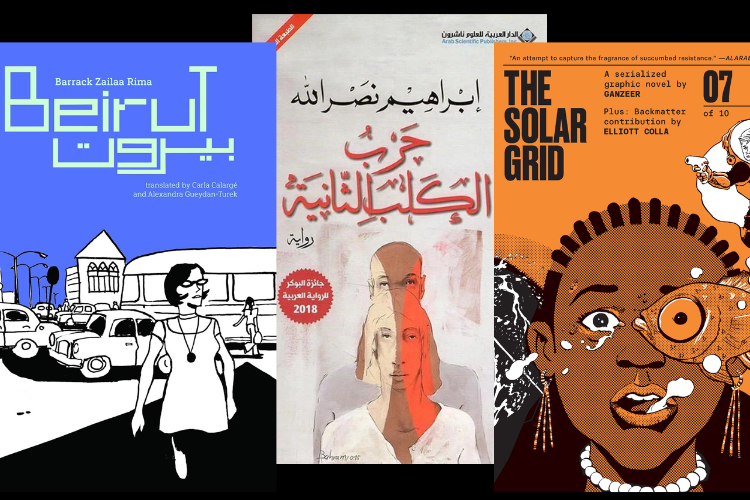
Beirut by Barrack Zaila Rima, Ibrahim Nasrallah’s The Second War of the Dog and The Solar Grid by Ganzeer.
While Anglophone publishing is intensely concerned with comparative titles and where a novel fits into the landscape, contemporary Arabic publishing largely is not. As such, there is no fixed terminology used for cli fi (climate fiction) in Arabic—though there is fiction that looks much like cli fi in English: works concerned with the consequences of anthropogenic climate change and more specifically with long-term shifts in weather patterns sparked by greenhouse gas emissions. It might be called adab taghayyur al-manakh (“literature of climate change”), al-adab al-biʾi (“environmental literature”) or even a transliterated klaymat fikshun.[1]
The genre is not as popular in Arabic—a fact which some critics, like Egyptian journalist and short story writer, Ahmed al-Khamissi, have lamented. But sci fi author Emad El-Din Aysha suggests that the Western affection for dystopia could also be seen as a luxury. He writes that people grappling with “real-life anxieties around every corner” have less need to invent them.[2] Generally, there seems to be more climate fiction in the form of graphic novels and animated short films. In part, these projects are more easily funded within international projects, but they are also forms that invite experimentation.
Taking a slightly broader view that moves beyond near-future speculation finds many Arabic fictions concerned with the consequences of human actions on the natural world: Abdelrahman Munif’s Cities of Salt (1984) on the impact of oil; Ibrahim al-Koni’s The Bleeding of the Stone (2013) and plenty of other novels, about the impact of humans on desert landscapes; and Ismail Fahd Ismail’s The Old Woman and the River (2017), chronicling how war reshapes the natural environment.
When Omani writer Zahran Alqasmi won the 2023 International Prize for Arabic Fiction for his The Water Diviner, which is set in the present, several of the judges raised the issue of climate change. The novel itself doesn’t foreground climate disaster. But many readers seem to have read it into this novel, in which a village’s irrigation system is fundamental to social relationships and systems. Similarly, many of the books and short stories by Nubian writers chronicling the impact of the Aswan dam can be read as climate fiction, as Christine Anna Gilmore argues.[3]
But for the sake of this MER issue, on the politics of a post-carbon future, below are a few titles from the Maghreb and Mashriq, largely written in Arabic, that line up more neatly with what readers typically mean by climate fiction in English.
Dystopias, Both Ugly and Beautiful
Environmental catastrophe provides an essential origin story for many dystopias, including Ibrahim Nasrallah’s The Second War of the Dog, which won the International Prize for Arabic Fiction in 2018. This near-future dystopia—by an author best-known for his historical fictions—focuses on the intersections of technological developments and the corruption of power, most prominently through “forged” copies of human beings: A machine can transform one person into the doppelgänger of another, accelerating our ability to manipulate and exploit one another and shrinking the space for individual identity. The backdrop to the novel is a climate catastrophe that has boxed humans into a corner, with changes in the atmosphere and agriculture and birds falling dead from the sky. Here, climate disaster acts as an intensifier of social and political horrors, as well as a commentary on the narrative of human progress.
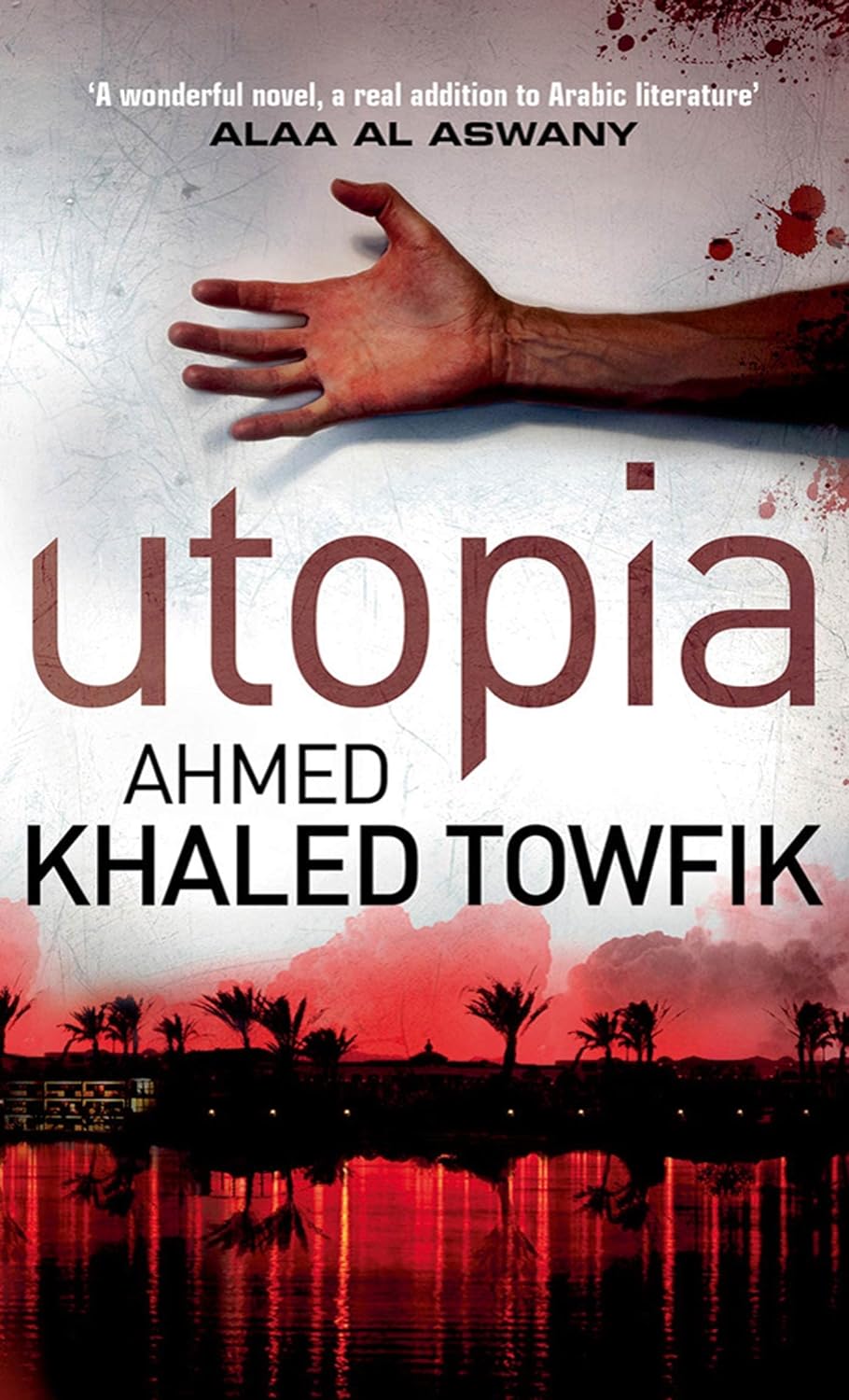
Utopia by Ahmed Khaled Towfik.
Several other near-future dystopias, such as Mohamed Rabie’s Otared (2016) and Ahmed Khaled Tawfiq’s Utopia (tr. Chip Rossetti, 2012), focus more on political systems, but the environment is close at hand. As Teresa Pepe points out, in the latter of the two, economic and ecological disaster stand at the root of the novel’s dystopic vision.[4] These catastrophes were brought on by the collapse of fossil fuel production, leading to a violent separation between the rich and the poor. The work is set in and around a future suburban compound that has as a border as militarized as a country’s. Within the walled-off compound, which is protected by US soldiers, the rich hoard virtually all of Egypt’s resources, leaving almost nothing for the Egyptians who still live in their old cities.
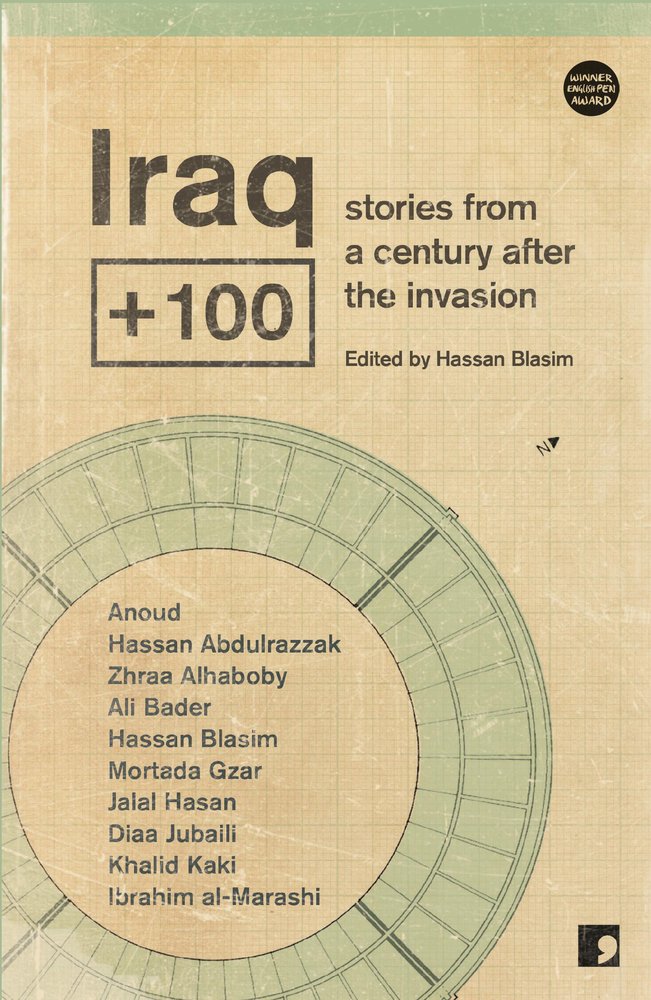
Iraq +100: Stories from a century after the invasion, edited by Hassan Blasim.
In Ahmed Naji’s And Tigers to my Room (2020), which is currently being adapted to film by Hamsa Production House in Brooklyn, the action ranges across thousands of years of history, from distant past to near future. The novel confronts how large-scale utopic architectural projects currently being planned—like Saudi Arabia’s floating industrial complex and linear city, NEOM—are the same sort of extractionist, authoritarian enclaves we find in Utopia. Rather than living in the cities that rose up over thousands of years, such as Cairo, people live in artificially crafted new cities that suck up resources in order to produce an artificial grandeur. When one of the central characters arrives in NEOM, she sees, “great green pastures for the camels, greater ones yet for golf courses, shepherds each one taller than the next, three Magian stars, streets laid out in geometric grids like civilization, vast tracts of tropical garden beneath glass domes, art works and sculptures in huge laser-lit squares.”[5] It is a bright and impossible promise of environmental and social idyll.
Notable climate fictions can also be found in the stories published as part of Comma Press’s “future past” series, in which authors are charged with setting their stories 100 years after a defining historical event. For Palestine + 100 (2019), it is the 1948 Nakba, while in Iraq + 100 (2016), it is the start of the US-led invasion in 2003. In Saleem Haddad’s “Song of the Birds,” published in the anthology Palestine + 100 (edited by Basma Ghalayini), a false utopia is plastered over the top of a climate dystopia to keep residents pacified. In Hassan Blasim’s “The Gardens of Babylon,” (translated by Jonathan Wright and published in Iraq + 100), the city of Babylon must be supplied with water by “water trains” that come from central and northern Europe. In the story, the Water Rebels don’t like the way this resource is being shared. After all, “some people hardly seem to have enough e-credit to pay for their quota, while in rich areas you see special trucks filling swimming pools and fountains with the stuff.”[6]
The latest collection Kurdistan + 100 (2023), edited by Orsola Casagrande and Mustafa Gündoğdu, also has several notable fictions that highlight a future of biodiversity collapse—one in which Kurds are further marginalized and cut off from their pasts.
Happily Ever After—Stories that Fix the Climate
Not all Arabic cli fi is gloom and dystopic doom. There are also wish-fulfillment stories in which the characters find a way to win out over destructive systems.
Lebanese novelist Ghassan Chebaro’s 2022, published in 2009, is essentially a battle between climate activist Diana Faris and climate destroyer Mansour Qashush. In the end, Diana gets a seat in the Lebanon’s parliament from which she can pursue her environmental goals.
The ending paints a far brighter picture than most Lebanese writing on climate, including the darkly comic “Wasting Away” by Lina Mounzer—a story about Lebanon’s trash that was published in the anthology Tales of Two Planets (2020). Barrack Zaila Rima’s time-traveling Beirut trilogy of graphic novels (2017), translated by Carla Calargé & Alexandra Gueydan-Turek, also features a Lebanon in which trash is relentless. Yet another unhappily-ever-after view of Lebanon’s garbage crisis comes in Mounia Akl’s 2016 film Submarine, where one young woman attempts to hold off the apocalypse by creating beauty in her own home and refusing to evacuate in the face of environmental collapse. Although the film is speculative fiction, Akl said in an interview with Joey Ayoub that they “mixed production design locations and relocations to work on that thin line between dystopia and present reality,” showing, for instance, a real dump in Nahr Beirut.[7]
In Maria Dadouch’s I Want Golden Eyes (2019), technology increases the chasm between the haves and the have-nots. But in The Mystery of the Glass Ball, published in 2021 and catered toward somewhat younger readers, the story takes place in a future where humans have managed to preserve the deserts of the Arabian Peninsula thanks to good stewardship and the use of technology. In the novel, a boy comes across two criminals who want to ruin this beautiful future by poisoning an oasis and killing off animals in a desert sanctuary. Naturally, he doesn’t let them get away with it.
Experiments in the Graphic Novel, Photography and Animated Film
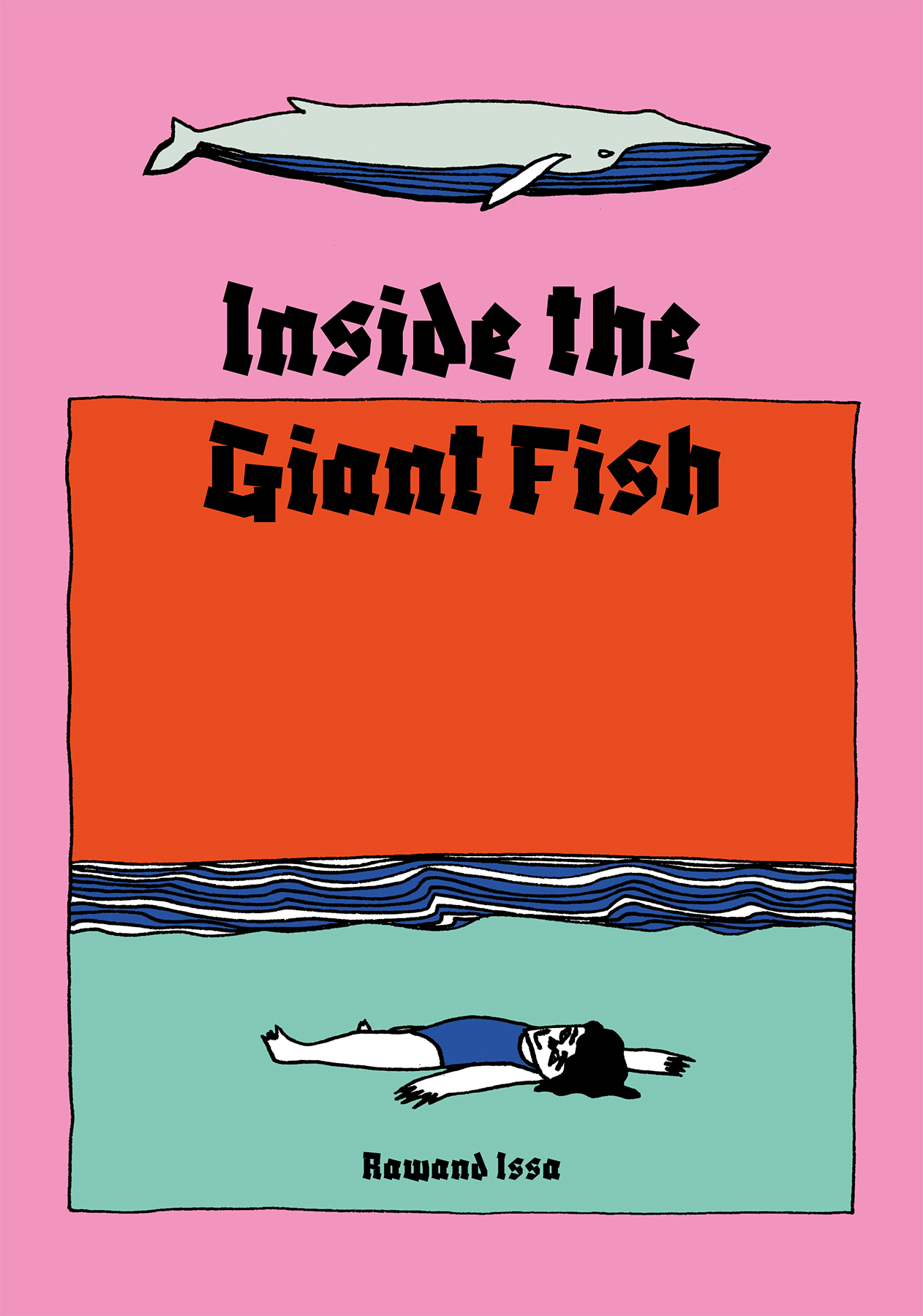
Inside the Giant Fish by Rawand Issa.
Some of the most interesting approaches to climate change in Arabic literature have come in graphic novels and other hybrid forms. Rawand Issa’s Inside the Giant Fish, translated by Amy Chiniara (2023), like Rima’s Beirut trilogy, melds contemporary documentary and magical form.
Climate change is also one of the background movers in Ahmed Naji’s experimental 2016 hybrid graphic novel Using Life, illustrated by Ayman Al-Zorkany and translated to English by Ben Koerber. In the work, a tsunami-like sandstorm buries Cairo, after which come the earthquakes. Here, with historic Cairo largely destroyed and a “new Cairo” springing up on its outskirts, Naji crafts both a portrait of intimate relationships in the shadow of dystopia and a satire of global power.
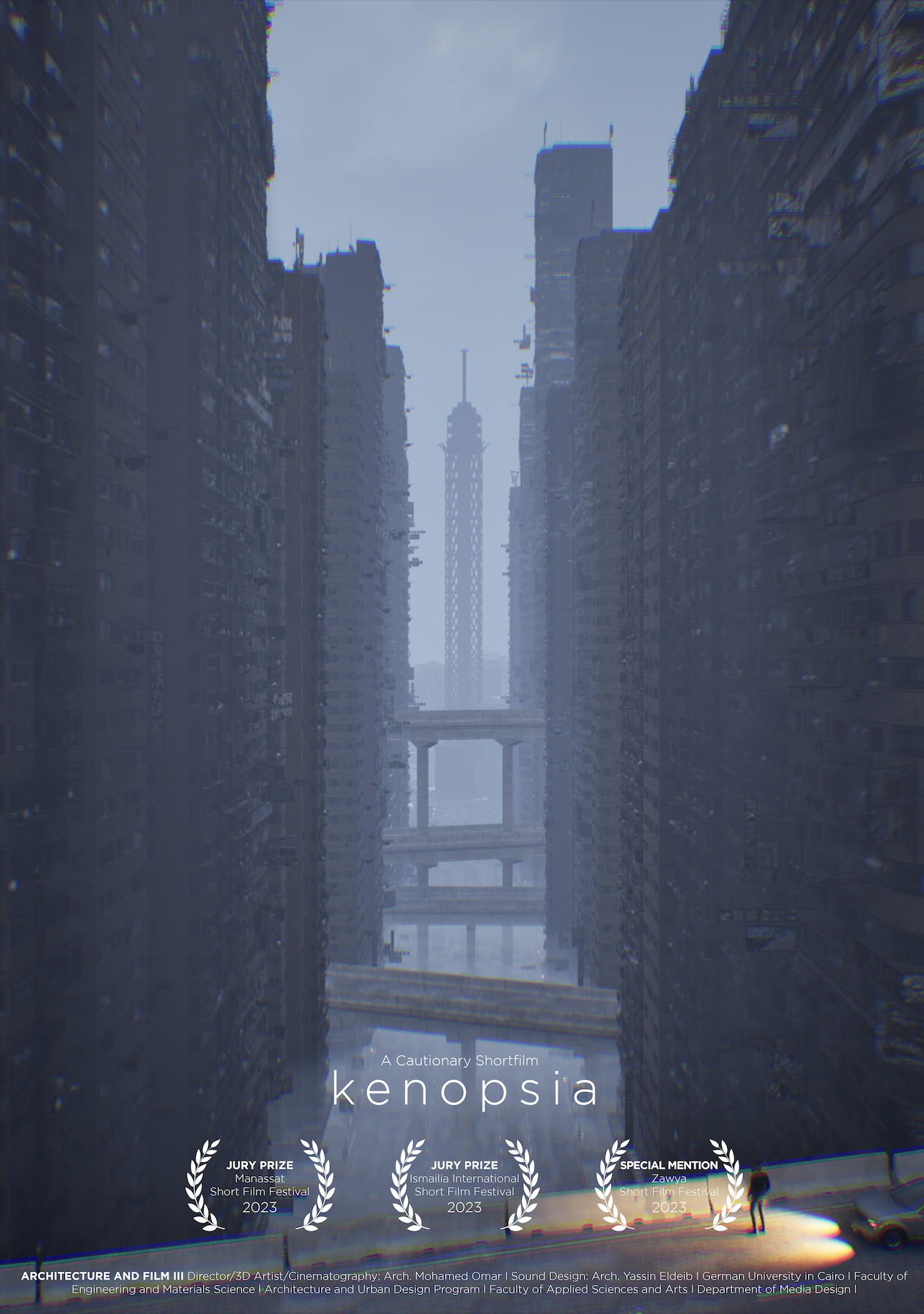
Poster for the film “Kenopsia” by Mohamed Omar.
Seif Kousmate’s photography and poetry project Waha (“oasis”)—which, in 2022, he announced he was turning into a book—offers an essential exploration of water, one that observes, in real time, as this essential resource evaporates. As part of Waha, Kousmate has not only been photographing the changes to Morocco’s oases but also gathering poetry and testimonies from residents, in a project he calls “poetic documentary photography.”[8]
Mohamed Salah’s “8 Minutes” is a comic created for an exhibition on climate change in collaboration between the Swedish institute in Alexandria and the Mazg Foundation. Set in Alexandria, the work focuses on rising sea levels, taking a much bleaker look at the future than Subhi Fahmawi’s Alexandria 2050. In Salah’s world, rising sea levels have ushered in a violent, opportunistic lawlessness. Against this backdrop, Salah searches for a moment of beauty to depict and finds a man and woman who risk venturing out into this dangerous world for eight minutes to watch the sunset.
Tenderness and wonder amid the climate ravaged future are also at the heart of Mohamed Omar’s animated short film “Kenopsia,” which is set in an empty Cairo, to which an old man returns in search of his childhood home. The film offers a bleak vision: Tahrir Square is full of abandoned camps that were used to shelter refugees from Alexandria after it was flooded. One must wear a mask in order to breathe. In the quiet landscape, the viewer joins the main character in his nostalgia for the semi-breathable chaos of today’s Cairo.
[Marcia Lynx Qualey is the founding editor of ArabLit and ArabLit Quarterly.]
Endnotes
[1] Teresa Pepe, “Climate Change and the Future of the City: Arabic Science Fiction as Climate Fiction in Egypt and Iraq,” Middle Eastern Literatures 26/1 (2023), p. 100.
[2] Emad El-Din Aysha, “Double Trouble: Moataz Hassanien’s ‘2063’, charting a course for today, from the world of tomorrow!,” Liberum, January 15, 2019.
[3] Christine Anna Gilmore, “Dams, Displacement and Development in Narratives of the Nubian Awakening,” PhD Thesis, The University of Leeds, June 2016.
[4] Teresa Pepe, “Climate Change and the Future of the City: Arabic Science Fiction as Climate Fiction in Egypt and Iraq,” Middle Eastern Literatures 26/1 (2023), pp. 99–118.
[5] Ahmed Naji, “Excerpt from Naji’s Novel And Tigers to my room” (translated by Robin Moger), Pen/Opp, February 25, 2022.
[6] Iraq + 100: Stories from a Century after the Invasion, ed. Hassan Blasim (Comma Press, 2016), p. 13.
[7] Elia J. Ayoub, “In Conversation with Mounia Akl, Director of ‘Submarine,’” Hummus for Thought, July 17, 2018.
[8] “Degradation through Aesthetics and Poetry: An Encounter with Seif Kousmate on ‘Waha’,” AFAC Arab Fund for Arts and Culture, June 10, 2022.
